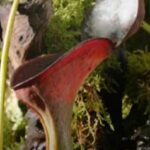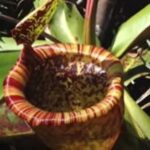As an Amazon Associate, this site earns commissions from qualifying purchases. For more details, click here.
Learning how to care for pitcher plants during winter is key to their survival. While these plants can adapt to different environments, most will freeze under extreme cold. So it is crucial that you understand how much cold they can handle and what conditions are ideal. This article contains the essential facts you need to accomplish this.
Majority of pitcher plants cannot survive below 0 to 10 F or -17.8 to -12.2 C (USDA zone 7). While these plants have to be in cold weather during dormancy, they will need protection in locations colder than zone 7.
US Hardiness Zone and Pitcher Plants
How to care for pitcher plants in winter depends on which hardiness zone you live in. Knowing your hardiness zone is a must to grow any plant or tree successfully.
The US is divided into 13 zones. The following table shows the lowest average temperature in each zone. Use this guide to find out which area you live in.
US Hardiness Zone Table
| Zone | Fahrenheit | Celsius |
|---|---|---|
| 1 | -60 to -50 | -51.1 to -45.8 |
| 2 | -50 to -40 | -45.6 to -40 |
| 3 | -40 to -30 | -40 to -34.4 |
| 4 | -30 to -20 | -34.4 to -28.9 |
| 5 | -20 to -10 | -28.9 to -23.3 |
| 6 | -10 to-0 | -23.3 to -17.8 |
| 7 | 0 to -10 | -17.8 to -12.2 |
| 8 | 10 to 20 | -12.2 to -6.7 |
| 9 | 20 to 30 | -6.7 to -1.1 |
| 10 | 30 to 40 | -1.1 to 4.4 |
| 11 | 40 to 50 | 4.4 to 10 |
| 12 | 50 to 60 | 10 to 15.6 |
| 13 | 60 to 70 | 15.6 to 21.1 |
Please keep in mind that the USDA hardiness zone is only a general guide. In the end you have to see how well the plant reacts to winter. If it seems cold for a zone 7 for instance, move the plant to a warmer location. Remember though that pitcher plants which go dormant like sarracenia must still be placed in a cold (though not freezing) environment.
How Much Cold Can Pitcher Plants Tolerate?
To make it very clear, only sarracenia pitcher plants go dormant. Nepenthes are tropical pitcher plants and do not require dormancy. You have to avoid this confusion as it could be fatal to your plants.
In general if the sarracenia pitcher plant grows naturally in your area, it can survive winter outdoors. But some sarracenia variants may be more hardy than other species. Here are some general guidelines.
- Sarracenia pitcher plants that grow in zone 6 (-10 to 0 F / -23 to -17.8 C) can survive the cold freeze, provided it is not prolonged.
- Pitcher plants that grow in zones 6-7 can be kept outdoors during winter. They only require protection if it is colder than usual.
- Sarracenia purpura is one of the few pitcher plants that can handle zone 5 (-20 to -10 F / -28.9 to -23.3 C).
- Pitcher plants in zones 5 and lower will need protection from the cold. They cannot survive winter outdoors.
If you have sarracenia pitcher plants, expect them to go dormant in the winter. If they can handle the cold, leave them outdoors. Otherwise, provide some protection but make certain they are still in a cold location.
Nepenthes are different from sarracenia. They do not need dormancy and thrive in the same temperature all year round. Their growth slows during winter but do not go dormant like sarracenia. You can grow them indoors or in a terrarium like Urban Born Glass as long as their requirements are met.
Nepenthes pitcher plants cannot survive very cold, wintry conditions. Move them indoors and keep the temperature around 60-85 F.
While sarracenia pitcher plants undergo dormancy, the length of time differs. Some go dormant much earlier than others, and some variants have a longer cycle. Their temperature and humidity requirements also differ. This is why you should learn as much as you can about the pitcher plant variant and its life cycle.
Why Pitcher Plants Go Dormant
When a pitcher plant goes dormant, its growth stops. The leaves turn brown and falls off, its roots shrink, the plant stops eating and looks dead. Dormancy is all about preserving energy as the cold weather makes it difficult for the plant to photosynthesize. For more about this topic check out our post explaining pitcher plants and chlorophyll.
Sarracenia pitcher plants naturally grow in areas with the four seasons, spring, summer, fall and winter. They blossom in spring and summer and go dormant in winter. You can see the signs of dormancy in late fall with some variants.
If the plant is indoors, you have to adjust its environment depending on the season. During the growth period, pitcher plants require:
- The humidity must be 35% minimum. Some species prefer 50% or higher.
- A ventilated area with good airflow.
- The soil must be nutrition free. Peat moss or long sphagnum moss is ideal.
- Growing pitcher plants have to eat at least once a month.
- Keep the temperature around 65-85 degrees F. Some sarracenia species can handle 90-100 F for brief periods.
As fall arrives, keep an eye on the plant. If its leaves start to fall, it is getting ready to go dormant. Some things you can do to help the process:
- If the plant is indoors, relocate to a colder area.
- Water the plant just enough to keep it moist. Leave it there for 3 months or so. The dormancy period varies so check the timetable for your sarracenia.
When dormancy ends, you can slowly expose it to light and food. Note that pitcher plants should not be subjected to freezing until it is dormant. A very damp soil could also lead to root rot so do not over water. We suggest Ice Mountain Spring Water as it is free of chemicals that could harm pitcher plants.
Caring For Dormant Pitcher Plants
Pitcher plants in zones 6 and 7 can cope with short winter freezes. When the temperature stars to drop, it is a signal for pitcher plants to go dormant. When the temperature rises in the spring, it is time for them to reemerge. This is why it is so important that you simulate their natural environment as accurately as possible.
If the pitcher plant grows naturally in your zone, you can leave it outdoors. If it gets too cold, take the plant indoors to an unheated area (the garage, shed etc.). Or you can put mulch along the plant base to protect it.
If you are sitting pitcher plants in water, make sure the liquid has not frozen over. Use only an inch or so of water and move the plant indoors if it gets too cold. If you own S. purpura and other hardy carnivorous plants, you can keep them outdoors in zone 5 winter conditions.
Dormant pitcher plants need less water than usual. Do not let the soil dry, but it does not have to be as moist as usual. Never fertilize the soil of pitcher plants especially when dormant.
When a pitcher plant starts to grow in the spring, you can start feeding it. Of course you do not have to do any feeding if your sarracenia is outside as insects are all over the place.
Pitcher Plant Winter Tips
- Do not touch pitcher plants when they are dormant. In fact it is a good idea not to touch them at all because it can stress the plant.
- Pitcher plants can thrive in winter under the right conditions. Nepenthes do not require dormancy so you can raise them indoors in a terrarium or even a greenhouse. As long as there is proper light, humidity, temperature, water and soil, the plant will live.
- If you have a sarracenia pitcher plant indoors, you have to make its environment as natural as possible. This also applies if the plant is outdoors. Sarracenia requires dormancy and without it, the plant will not be as healthy come spring.
- Do not use strong pesticides on pitcher plants.
The key to caring for pitcher plants in winter is balance. Most cannot survive in zone 5 and below, but they still need cold weather. So you have to keep the temperature at around zone 6 to 7 levels. Anything under 60 degrees is ideal, but some plants may prefer colder weather.
If you are going to bring a sarracenia plant indoors during winter, they have to be kept in the right place. The temperature has to be cold without being overly so. Keep the plant there until winter ends. Then you can take it outside so it gets accustomed to the warmth again.
Conclusion
Pitcher plants require special care during winter so you have to plan ahead. The first step is recognize whether you have sarracenia or nepenthes, and what USDA zone you are in. By balancing the need for cold weather with freezing temperature, you can ensure their survival come spring.

My fascination with carnivorous plants began many, many years ago with Venus Fly Traps. Now I am more than happy to impart what I know with other enthusiasts and those who are curious about meat eating plants.



